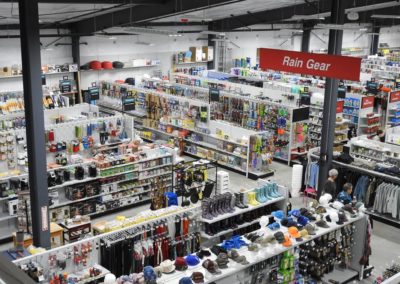Buck Electric Ace Hardware
Success StoryPaladin, Pointy Help Buck Electric Get Products Online
Buck Electric Ace Hardware is like a lot of independent businesses today. It’s a great local store for the roughly 6,000 people who call Ocean Shores, Washington home. But in the rapidly evolving retail environment, it’s having to compete for customers with e-commerce businesses with no ties to the city, county, state and, in some cases, even the country.
Digital technologies have become increasingly important for independent businesses. Statistics show that retail sales in 2018 totaled $3.7 trillion across all categories, and 92% of those sales were influenced by digital factors such as online marketplaces and reviews, advertising and marketing, and mobile searches. That’s why having powerful in-store tools combined with a strong digital business presence is so important today.
Buck Electric, which partnered with Paladin Data Corporation in 2009, recently added a new weapon to its digital arsenal when it began using Pointy to promote its products online.
Pointy leverages Buck Electric’s unique inventory and pricing data within Paladin and promotes its products within local Google searches. This allows the residents of Ocean Shores to view Buck Electric’s vast selection of items that they could pick up within minutes. No online ordering or waiting for delivery necessary.
“It is very cool! Particularly for us because we live and work in a remote area, it seems like everybody today just clicks on Amazon.com to shop and there are a lot of items we have that are the same price. This gives us the chance to get that sale first,” explains Jody Cadle, the business’s bookkeeper and de facto marketing guru with her experience from working in the hospitality industry.
The Pointy and Paladin integration levels the playing field for Buck Electric Ace Hardware in its competition against the giant marketing budgets of Amazon, Lowe’s and Home Depot. Even though the company dates back to 1977, added Ace Hardware in 1986, and has expanded twice since then – most recently to a 33,000-square-foot building – Jody says many people still think of it as just a hardware store. Pointy enables Buck Electric to drive local traffic to the store for all the products on its shelves; not just nuts and bolts.
Residents of the small coastal town, which rests on the southern tip of a strand between the Pacific Ocean and Grays Harbor, can get everything from electrical contractor supplies, to hardware and building materials, to housewares, clothing and even Washington-based specialty wines and spirits at the store. And now they can find those items online thanks to Pointy and Paladin.
Jody says downloading Pointy and getting products online was incredibly easy.
“It took literally five seconds to set up on the front end. The back end took only about 20 minutes to set up. We uploaded our item list and people were able to see our products online within minutes,” she says, adding taking the store’s item list out of Paladin took minimal effort, too.
“With the EDI loads out of Ace, being able to see when inventory came in, when it was received, how many we received, when we sold it, who we sold it to; Paladin provides insights about who is purchasing what. And we use that information to make better business decisions.”
In addition to Pointy, Buck Electric Ace uses Paladin’s many Ace integrations – electronic data interchange (EDI), Ace Rewards and Ace Order System (AOS) – to streamline its operations. As the company’s bookkeeper, Jody says she appreciates how easily Paladin works with Ace programs, QuickBooks and now Pointy.
“Paladin provides all of the insights we need. Coming from another retail industry, the inventory controls in Paladin are incredible. Inventory management is huge in selecting Paladin. You just don’t get those kinds of numbers in a lot of other industries,” she says. “With the EDI loads out of Ace, being able to see when inventory came in, when it was received, how many we received, when we sold it, who we sold it to; Paladin provides insights about who is purchasing what. And we use that information to make better business decisions.”




